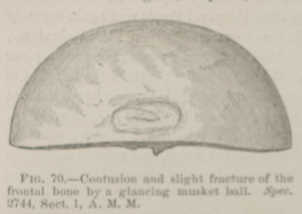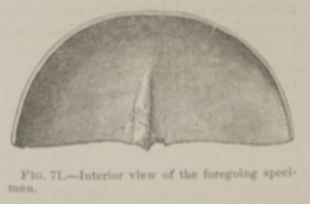Title: A——, William
Source text: Surgeon General Joseph K. Barnes, United States Army, The Medical and Surgical History of the War of the Rebellion. (1861–65.), Part 1, Volume 2 (Washington, D.C.: Government Printing Office, 1870), 161.
Civil War Washington ID: med.d1e11229
TEI/XML: med.d1e11229.xml
CASE.—Private William A——, Co. F, 11th Pennsylvania Volunteers, aged 29 years, was wounded at the battle of the Wilderness, Virginia, May 7th, 1864, by a conoidal ball which struck the frontal bone between the eminences, lacerating the muscles for about two inches and denuding the bone of periosteum for about one inch. The wound was considered slight. The patient was treated for several days in a field hospital, and on May 11th was sent to the Lincoln Hospital, at Washington, whence on May 18th, he was transferred to the Satterlee Hospital, Philadelphia. Cold water dressings were applied to the wound and the patient was able to be about all the time. He was in good condition and appeared to do well until May 31st, when he became irritable, and complained of severe pain in the head. The external wound still looked well. On the following day he became drowsy and suffered from nausea. The pain in the head continued unabated and the pulse was 110, but the mind clear. Small doses of creasote and lime-water were given and he was freely purged. On May 24th the nausea subsided and the pulse had risen to 120; no pain in the head, and the patient was rational though dull. On the 25th the pulse was weak at 130, but the patient seemed perfectly conscious, and his mind was clear, and he declared that he felt perfectly easy, yet he died suddenly at five in the afternoon. This is the report of Acting Assistant Surgeon J. K. Baldwin, yet his ward case book states that the patient survived until the 26th, having low muttering delirium in the early part of that day. The autopsy was made forty hours after death by Acting Assistant Surgeon Charles P. Tutt. He reported that though the periosteum was removed the external table of the skull was scarcely injured, except by a shaving of lead from the ball firmly imbedded beneath the outer lamina at the inner upper margin of the wound in the periosteum. On removing the calvaria a large amount of pus was found upon the dura mater of the anterior lobe of the left hemisphere beneath the seat of injury. On removing the pus a spiculum of bone from the inner table was found to perforate the dura mater and a large abscess extending into the anterior horn of the left lateral ventricle was found beneath. A large effusion of serum was found at the base of the brain, and a yellow deposit was found on the pons Varolii and medula oblongata and in the fissures of the cerebellum. A similar deposition of albuminous or puriform matter was also found under the arachnoid near the left ventricle. The viscera of the chest and abdomen were in a normal condition. The clinical history was furnished by Acting Assistant Surgeon J. K. Baldwin, who is also accredited with the specimen, of which an external and internal view is given in the accompanying wood-cuts, (FIG. 70, and FIG. 71.) The notes of the autopsy were furnished by Acting Assistant Surgeon Tutt who made it. In the external table a portion of bone measuring one-fourth by one inch, a small fragment of which is depressed one line and surrounded by a slight groove, indicated an incipient exfoliation. At the upper inner portion of this oval groove a bit of lead is impacted. The inner table beneath is fissured for one inch beneath the seat of injury.

